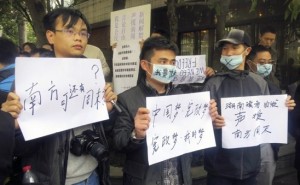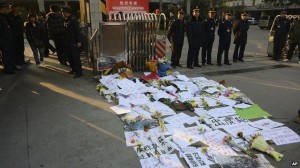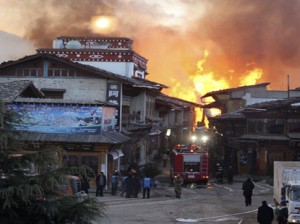
Some of the protesters carried banners that read: “We want press freedom,
constitutionalism and democracy”
One of China’s most respected and liberal newspapers is back on the shelves after a strike sparked by an act of government censorship put China’s suppressed freedom of expression back in the international spotlight, and incited speculation on what kind of political reform, if any, can be expected from China’s new leadership.
At the start of the New Year, a Southern Weekly editorial entitled “China’s Dream, the Dream of Constitutionalism”, demanding government reform and increased freedom was deleted from the newspaper by propaganda officials, and replaced with a pro-government tribute. This prompted a staff strike and citizen protests, and marked the first time in history, aside from the Tiananmen Square protests in 1989, that the government’s control of the press has been publicly challenged. The strike initiated dispute among the media, government officials, and zealous citizens.
In response to the government editing, two letters of protest were written by Southern Weekly’s most prominent members of staff demanding the resignation of Tuo Zhen, the head of the province’s “propaganda police” who monitor the media, and often edit material to favour the government agenda. This challenge to authority resulted in the Southern Weekly’s microblog being hijacked and edited by propaganda authorities, and all online discussion of the controversy was blocked on social media sites. Southern Weekly employees responded with a strike and this inspired citizen protests. Vehement pro-reformists demonstrated outside the newspaper headquarters in Guangzhou, in the progressive Guangdong province, holding placards displaying impassioned calls for reform, such as “Let’s chase our dreams together. Go Southern Weekly!” and “Get rid of censorship. The Chinese people want freedom!”
The protest also attracted pro-communist flag wavers, wielding photos of Mao Zedong and signs referring to the Southern Weekly and its supporters as “traitors”. The protesters clashed regularly, leading to some violence between the opposing sides and scuffles with the police.
The conflict even spread to the capital, Beijing, when the head of another major newspaper, the Global Times, refused to print a government produced editorial that demonized the Southern Weekly for its attempt to challenge media censorship, and declared that China was not ready for this kind of freedom of the press. After heavy pressure from government officials, the newspaper finally compromised, reluctantly, by publishing the article in a small section in the back pages of the paper.
 It has been reported that the strike and related protests have ended due to mutual agreements, including a promise by officials to relax some control of the press. Although the return of the Southern Weekly suggests a truce between the newspaper and government, it is unclear if there has actually been a fair resolution to the conflict, and reliable reform. The first printing after the newspaper’s return made no direct mention of the conflict, but did publish a vague narrative about how sometimes mistakes are made, seemingly minimalising the incident. Attempted communication by many outside news sources has gone unanswered by the Southern Weekly and its parent company. Editorial staff have not provided any comment as they have been instructed not to discuss the matter with foreign media.
It has been reported that the strike and related protests have ended due to mutual agreements, including a promise by officials to relax some control of the press. Although the return of the Southern Weekly suggests a truce between the newspaper and government, it is unclear if there has actually been a fair resolution to the conflict, and reliable reform. The first printing after the newspaper’s return made no direct mention of the conflict, but did publish a vague narrative about how sometimes mistakes are made, seemingly minimalising the incident. Attempted communication by many outside news sources has gone unanswered by the Southern Weekly and its parent company. Editorial staff have not provided any comment as they have been instructed not to discuss the matter with foreign media.
This incident has sparked speculation on what kind of stance on reform Xi Jinping will adopt when he is initiated fully into his new leadership role this coming March. Jinping’s rise to power has given many citizens hope for political liberalization and more openness to multi-party involvement. Knowing that this is his first test, Jinping has criticized the actions of the propaganda authorities and although no action has yet been taken, there are rumours that the offending official, Tuo Zhen, will be removed from his position. Jinping also reportedly gave orders to not punish the striking journalists or demonstrators. However, the ruling party has also demonstrated in this incident that it is not ready to allow freedom of the press, so the jury is still out regarding the future of censorship in China.




 Print
Print Email
Email